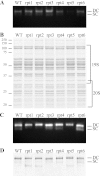Functional asymmetries of proteasome translocase pore
- PMID: 22493437
- PMCID: PMC3365715
- DOI: 10.1074/jbc.M112.357327
Functional asymmetries of proteasome translocase pore
Abstract
Degradation by proteasomes involves coupled translocation and unfolding of its protein substrates. Six distinct but paralogous proteasome ATPase proteins, Rpt1 to -6, form a heterohexameric ring that acts on substrates. An axially positioned loop (Ar-Φ loop) moves in concert with ATP hydrolysis, engages substrate, and propels it into a proteolytic chamber. The aromatic (Ar) residue of the Ar-Φ loop in all six Rpts of S. cerevisiae is tyrosine; this amino acid is thought to have important functional contacts with substrate. Six yeast strains were constructed and characterized in which Tyr was individually mutated to Ala. The mutant cells were viable and had distinct phenotypes. rpt3, rpt4, and rpt5 Tyr/Ala mutants, which cluster on one side of the ATPase hexamer, were substantially impaired in their capacity to degrade substrates. In contrast, rpt1, rpt2, and rpt6 mutants equaled or exceeded wild type in degradation activity. However, rpt1 and rpt6 mutants had defects that limited cell growth or viability under conditions that stressed the ubiquitin proteasome system. In contrast, the rpt3 mutant grew faster than wild type and to a smaller size, a defect that has previously been associated with misregulation of G1 cyclins. This rpt3 phenotype probably results from altered degradation of cell cycle regulatory proteins. Finally, mutation of five of the Rpt subunits increased proteasome ATPase activity, implying bidirectional coupling between the Ar-Φ loop and the ATP hydrolysis site. The present observations assign specific functions to individual Rpt proteins and provide insights into the diverse roles of the axial loops of individual proteasome ATPases.
Figures





Similar articles
-
Conserved proline residues in the coiled coil-OB domain linkers of Rpt proteins facilitate eukaryotic proteasome base assembly.J Biol Chem. 2021 Jan-Jun;296:100660. doi: 10.1016/j.jbc.2021.100660. Epub 2021 Apr 14. J Biol Chem. 2021. PMID: 33862083 Free PMC article.
-
The C terminus of Rpt3, an ATPase subunit of PA700 (19 S) regulatory complex, is essential for 26 S proteasome assembly but not for activation.J Biol Chem. 2010 Dec 10;285(50):39523-35. doi: 10.1074/jbc.M110.153627. Epub 2010 Oct 11. J Biol Chem. 2010. PMID: 20937828 Free PMC article.
-
Active site mutants in the six regulatory particle ATPases reveal multiple roles for ATP in the proteasome.EMBO J. 1998 Sep 1;17(17):4909-19. doi: 10.1093/emboj/17.17.4909. EMBO J. 1998. PMID: 9724628 Free PMC article.
-
Proteasomal AAA-ATPases: structure and function.Biochim Biophys Acta. 2012 Jan;1823(1):67-82. doi: 10.1016/j.bbamcr.2011.07.009. Epub 2011 Jul 23. Biochim Biophys Acta. 2012. PMID: 21820014 Review.
-
Proteasomes and their associated ATPases: a destructive combination.J Struct Biol. 2006 Oct;156(1):72-83. doi: 10.1016/j.jsb.2006.04.012. Epub 2006 May 8. J Struct Biol. 2006. PMID: 16919475 Review.
Cited by
-
Structural insights into proteasome activation by the 19S regulatory particle.Biochemistry. 2013 May 28;52(21):3618-28. doi: 10.1021/bi400417a. Epub 2013 May 14. Biochemistry. 2013. PMID: 23672618 Free PMC article.
-
Gates, Channels, and Switches: Elements of the Proteasome Machine.Trends Biochem Sci. 2016 Jan;41(1):77-93. doi: 10.1016/j.tibs.2015.10.009. Epub 2015 Nov 28. Trends Biochem Sci. 2016. PMID: 26643069 Free PMC article. Review.
-
Conformational switching of the 26S proteasome enables substrate degradation.Nat Struct Mol Biol. 2013 Jul;20(7):781-8. doi: 10.1038/nsmb.2616. Epub 2013 Jun 16. Nat Struct Mol Biol. 2013. PMID: 23770819 Free PMC article.
-
Proteasome interaction with ubiquitinated substrates: from mechanisms to therapies.FEBS J. 2021 Sep;288(18):5231-5251. doi: 10.1111/febs.15638. Epub 2020 Dec 11. FEBS J. 2021. PMID: 33211406 Free PMC article. Review.
-
The proteasome as a druggable target with multiple therapeutic potentialities: Cutting and non-cutting edges.Pharmacol Ther. 2020 Sep;213:107579. doi: 10.1016/j.pharmthera.2020.107579. Epub 2020 May 19. Pharmacol Ther. 2020. PMID: 32442437 Free PMC article.
References
-
- Groll M., Ditzel L., Löwe J., Stock D., Bochtler M., Bartunik H. D., Huber R. (1997) Structure of 20S proteasome from yeast at 2.4 Å resolution. Nature 386, 463–471 - PubMed
-
- Glickman M. H., Rubin D. M., Coux O., Wefes I., Pfeifer G., Cjeka Z., Baumeister W., Fried V. A., Finley D. (1998) A subcomplex of the proteasome regulatory particle required for ubiquitin-conjugate degradation and related to the COP9-signalosome and eIF3. Cell 94, 615–623 - PubMed
Publication types
MeSH terms
Substances
Grants and funding
LinkOut - more resources
Full Text Sources
Molecular Biology Databases
Research Materials

